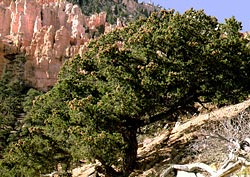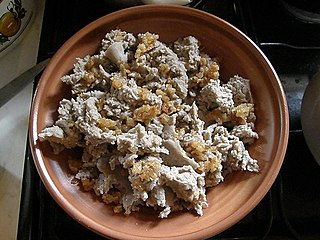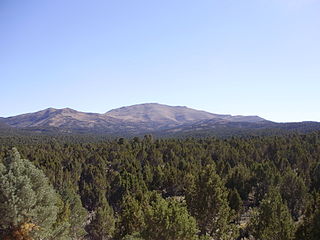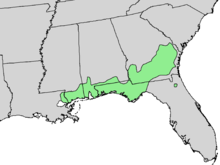
Buckwheat or common buckwheat is a flowering plant in the knotweed family Polygonaceae cultivated for its grain-like seeds and as a cover crop. Buckwheat originated around the 6th millennium BCE in the region of what is now Yunnan Province in southwestern China. The name "buckwheat" is used for several other species, such as Fagopyrum tataricum, a domesticated food plant raised in Asia.

Ptelea is a genus of flowering plants in the citrus family, Rutaceae. The name, of Greek derivation, is the classical name of the elm tree. Carl Linnaeus used that word for this genus because of the resemblance of its fruit to that of the elm. Members of the genus are commonly known as hoptrees.

Pinus edulis, the Colorado pinyon, two-needle piñon, pinyon pine, or simply piñon, is a pine in the pinyon pine group native to the Southwestern United States, used for its edible pine nuts.

Pinus monophylla, the single-leaf pinyon, is a pine in the pinyon pine group, native to North America. The range is in southernmost Idaho, western Utah, Arizona, southwest New Mexico, Nevada, eastern and southern California and northern Baja California.
Titi is a New World monkey in the genus Callicebus.

Ajdovi žganci is a sort of žganci. Translated to English, it would be termed "buckwheat mush" or "buckwheat spoonbread". It is a national Slovene dish. Balthasar Hacquet (1739–1815) mentions that žganci was served with sauerkraut in Upper Carniola. The oldest preparation method explains the word žganci. The word žganci is derived from the Slovenian verb žgati meaning "to burn" or "to toast". Ajdovi žganci are served together with obaras, meat sauces, sauerkraut, black pudding, and/or various sausages. The ingredients may vary through different regions.
Haplormosia is a monotypic genus of legumes in the family Fabaceae. Its only species is Haplormosia monophylla, commonly known as Liberian black gum, native to Cameroon, Ivory Coast, Liberia, Nigeria, and Sierra Leone. It is threatened by habitat loss.
Sarcotheca monophylla is a species of plant in the family Oxalidaceae. It is a tree endemic to Peninsular Malaysia.
The White Pine Range Wilderness is a 40,013-acre (16,193 ha) wilderness area in southwestern White Pine County, in the U.S. state of Nevada.
Pinyon Pines is an unincorporated community in Riverside County, California.

Eriogonum panamintense is a species of wild buckwheat known by the common name Panamint Mountain buckwheat. It is native to several of the desert mountain ranges of eastern California and western Nevada, including the Panamint Range. It grows in various types of mountain ridge habitat, such as sagebrush and coniferous woodland.

The Waterman Mountains are a low mountainous landform in Pima County, United States. Notable among the tree species is the elephant tree which species exhibits a contorted multi-furcate architecture; most of these froze in the cold winter of 2011. The Waterman Mountain range is in the Ironwood Forest National Monument.

Pinyon–juniper woodland, also spelled piñon–juniper woodland, is a biome found mid-elevations in arid regions of the Western United States, characterized by being an open forest dominated by low, bushy, evergreen junipers, pinyon pines, and their associates. At lower elevations, junipers often predominate and trees are spaced widely, bordering on and mingling with grassland or shrubland, but as elevation increases, pinyon pines become common and trees grow closer, forming denser canopies. Historically, pinyon-juniper woodland has provided a vital source of fuel and food for peoples of the American Southwest.

Harperocallis flava, known by the common name Harper's beauty, is a species endemic to parts of Florida in the United States, where it is known mainly from the Apalachicola National Forest in the Panhandle. It is seriously endangered and has been on the United States' endangered species list since 1979.

Nyssa biflora, commonly referred to as the swamp tupelo, or swamp black-gum is a species of tupelo that lives in wetland habitats. Swamp tupelo grows chiefly in the coastal plains from Delaware, eastern Maryland, and southeastern Virginia, south to southern Florida and west to eastern Texas. Its range extends north up the Mississippi Valley to southern Arkansas and west and south Tennessee.
Titi swamp is a swamp habitat in Florida and Georgia where species of Cliftonia monophylla and/or Cyrilla racemiflora predominate. Titi swamps are characterized by their nutrient rich and wet soil that is ideal for the growth of Cliftonia monophylia and Cyrilla racemiflora, which are both perennial trees/shrubs.

The Southeastern conifer forests are a temperate coniferous forest ecoregion of the southeastern United States. It is the largest conifer forest ecoregion east of the Mississippi River. It is also the southernmost instance of temperate coniferous forest within the Nearctic realm.
The southern coastal plain blackwater river floodplain forest is a forest system found in Alabama, Mississippi, Florida, and Georgia. These forests occur in the drainages of blackwater rivers and streams whose dark water is caused by high levels of tannins, particulates, and other materials accumulated as they drain through swamps and marshes. The water has little mineral sediment and few suspended clay particles.

The Southern coastal plain nonriverine basin swamp is a wetland system found along the southern Atlantic coastal plain and the eastern Gulf coastal plain, and extending into the Florida peninsula. These wetlands occur in large, seasonally flooded depressions away from rivers. Sites are often forested by trees including bald cypress, swamp tupelo, evergreen shrubs, and hardwoods. Slash pine is sometimes found. Characteristic shrubs include buckwheat tree, swamp cyrilla, fetterbush lyonia, and laurelleaf greenbrier.

Monophylla is a genus of checkered beetles in the family Cleridae. There are at least four described species in Monophylla.
















